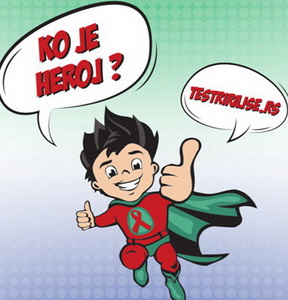 Author: Dražen Zacero (Social Inclusion Blog)
Author: Dražen Zacero (Social Inclusion Blog)
A small group of people living with HIV in Serbia are heroically fighting for a decent life. Not because of the virus, because it is no longer a deadly disease, but a chronic health condition that could lead to severe health problems if therapy is not taken regularly. They are heroically fighting to be part of society and be users of healthcare protection like all other chronic patients.
According to data from the Public Health Institute of Serbia, there are 3098 persons infected with HIV registered in Serbia. According to available data, an HIV infection epidemic was registered in the Republic of Serbia in late November 2014. Among the 95 newly discovered persons infected with HIV, 54 persons (57%) are from Belgrade, 14 (15%) from Vojvodina, and a quarter are from other districts in Central Serbia (27 persons). Most of the newly discovered HIV positive persons are 20-49 years of age (85 persons, i.e. 89.5%), with one in three persons being young, aged 20-29 (30 persons, or 32%). Of particular concern is that over 70% of the persons living with HIV/AIDS in Serbia are living under the poverty line. However, only 3% have submitted requests for financial support by the state, despite meeting the conditions, because of the stigma and lack of support in local communities, as well as lack of legal assistance (…)
The issue of AIDS needs to be treated as any other immunological issue, i.e. without discrimination. This requires a clear normative, financial and institutional framework that is currently not rounded off, and therefore just over 3,000 people with HIV/AIDS must live without being able to receive adequate psycho-social assistance and support, despite being extremely discriminated against due to the fear caused by lack of knowledge, stigmatizing these people, making it hard for them to find jobs, have a normal social life, and often even go to the dentist unless they hide their health status.
The AS centre for empowerment of youth living with HIV/AIDS deals with services of psychosocial assistance and support with medical assistance comprised of procurement of medicines, peer counselling, groups for self-help, individual online counselling as well as counselling in the offices with privacy and confidentiality. The delivery of medicines to beneficiaries unable to pick them up themselves is also envisaged, along with house calls, counselling in the field: on the street, in parks, parties, treatment clinics, and the counsellors in the field also do referrals to contacts and offices of the AS centre in order to reach the highest possible number of beneficiaries needing assistance that would not have learned about the service any other way. (…)
The campaign “Who is a Hero?” financed by the Ministry of Youth and Sports and implemented by the AS Centre is currently under way. It is an association founded by people who live with HIV, know great jokes, are excellent dancers, are cheerful, good people, helping their friends and neighbours. Help them by not making them feel as if they live in a balloon because no one may touch them. The idea of the campaign is to promote the inclusion of persons living with HIV/AIDS through reducing the stigma by way of promotional activities in the community and educational workshops for youth.
Through the social activism of members of the vulnerable groups, as well as their participation in activities aiming to provide support and assistance to youth with HIV, the project will contribute to increasing the quality of life for young people living with HIV and AIDS. Work will be done on empowering and inclusion in social life of this multiply discriminated group, work on personal improvement and individual development and the reduction of stigma and discrimination through public communications and inclusion, i.e. inviting the community to act together. The campaign “Who is a Hero?” will show the social status of people with HIV, and young people will be stimulated to get tested for HIV, to regularly use protection and become involved in the active promotion of healthy lifestyles, tolerance, equality and respect for human rights, freedom and diversity.
The text in its entirety can be found on the Social Inclusion Blog.
 Government of the Republic of Serbia
Government of the Republic of Serbia















 pdf [271 KB]
pdf [271 KB]
Leave a Comment